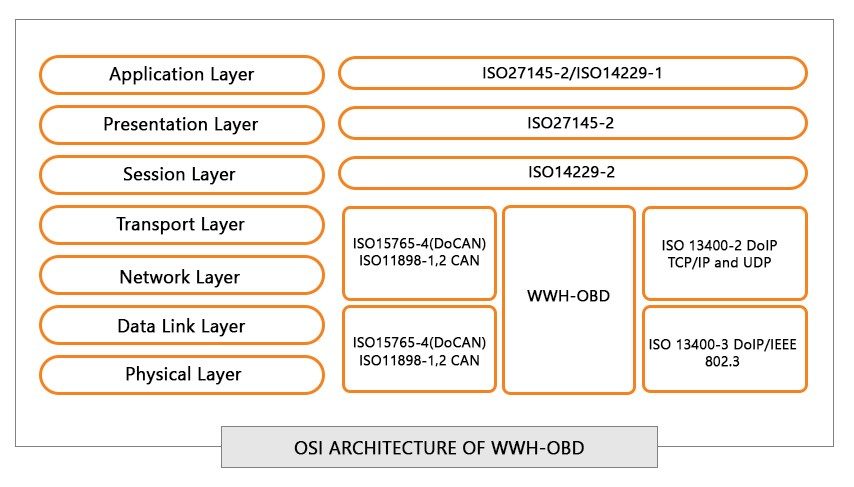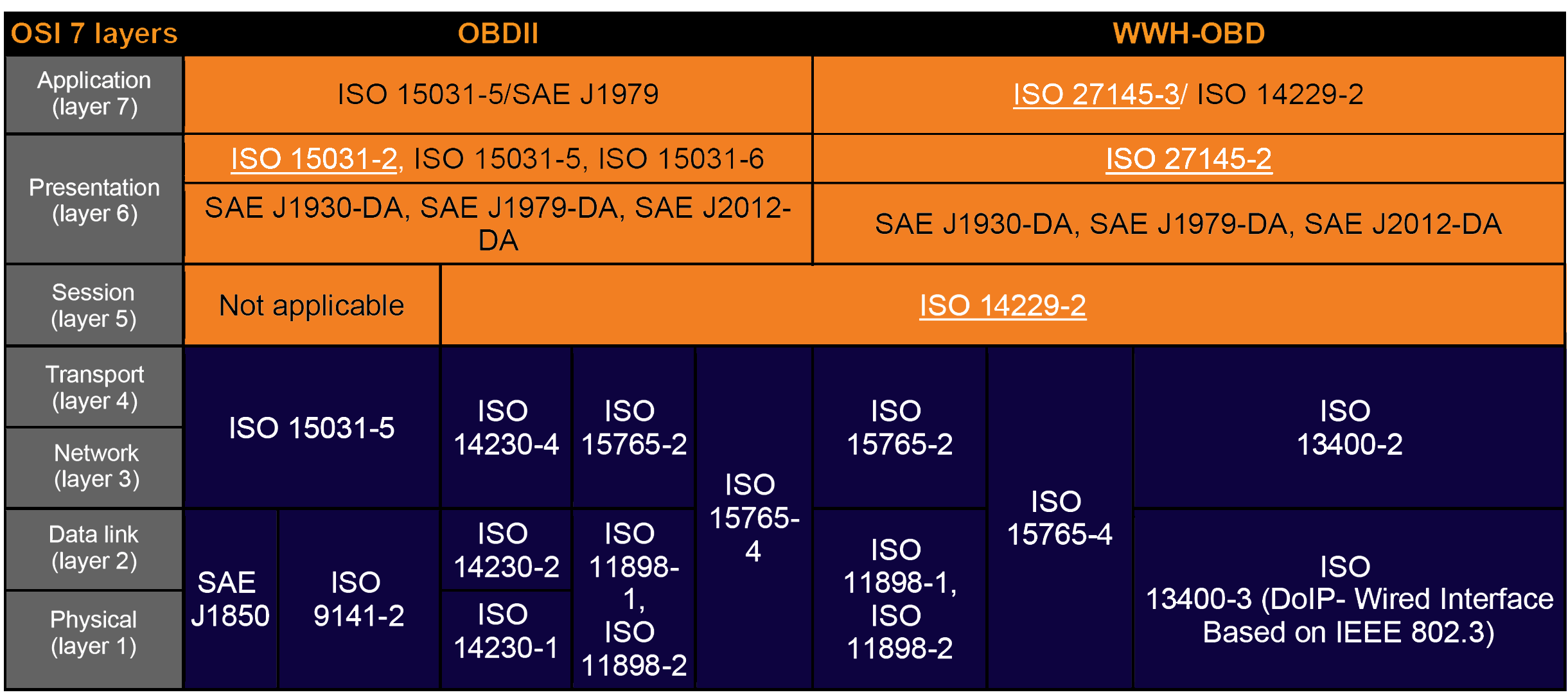On-board Diagnostics, popularly known as the OBD, has been at the helm of vehicle diagnostics since the early 80’s. Made mandatory in almost the entire automotive industry, OBD was adopted very rapidly among the OEMs.
However, due to the lack of standardization, most OEMs developed their own regional version of OBD. Although, they were built on an identical concept and architecture, the services, parameters and methods were totally different. In other words, if these distinct OBD systems had to interact with each other, compatibility issues would creep in.
Over some decades, the automotive OEMs, organizations like ISO and SAE and other stakeholders have been pushing for standardization in the development of automotive components. And that included On-board diagnostics as well. Around 1996, the second version of OBD, called the OBD II was launched with some enhanced services (Modes), PIDs (Parameter Identifiers) and Diagnostic Trouble Codes (DTCs)
But was the OBD II enough for a vehicle’s on-board diagnostics considering advanced features such as Telematics where external entities would also interact with the OBD system? Or was a world-wide harmonized version of OBD required?
We got in touch with one of our automotive experts to reveal the answer!
Let’s start with understanding, what is WWH-OBD?
How do you Define WWH-OBD in the Simplest of Terms?
As the name suggests, Word Wide Harmonized OBD is a standardized version of on-board vehicle diagnostics and is based on the ISO standard- ISO 27145. It was established by GTR (Global Technical Regulations) to push for a more enriched version of OBD system. Theoretically, the Unified Diagnostic Services (ISO 14229-1) was included to the vehicle’s on-board diagnostics system.
The WWH-OBD standard enables the communication between the vehicles OBD system and the external test equipment. And like many other communication and diagnostics protocols, it is based on the 7-layered OSI model.
Let’s examine the WWH-OBD architecture closely.

- The Application Layer comprises the diagnostics services specified in ISO 27145-2 (common data dictionary) in reference to the Unified Diagnostic Services (ISO 14229-2).
- The Presentation Layer which is responsible for data translation and encryption/decryption, is also based on the ISO 27145-2 standard. It is in reference to other standards as well, such as SAE J2012, SAE J1979, SAE J1939-73, etc. Some legally binding Diagnostic Fault Codes and data definitions are enlisted in these standards which is mandated to be implemented in the On-board diagnostics system.
- The Session Layer is managed by UDS (ISO 14229-2).
- Being a harmonized protocol equipped to be implemented for modern automotive applications, the Transport and Network Layers assume much importance here. Diagnostics over CAN (ISO 15765-2 and ISO 15765-4), DoIP and ISO 27145-4 (communication between external tester and vehicle) are integral part of these layers.
- The Data Link Layer is specified with reference to CAN data link layer, DoCAN, DoIP- Wired Interface as per IEEE 802.3
- The Physical Layer is also quite diverse as it supports CAN BUS protocol, DoIP (Wired Vehicle Interface based on IEE 802.3) and DoCAN.
Why was the Need Felt for a World-Wide Harmonized OBD?
The answer lies in the name of the new protocol- World-Wide Harmonized. Over the past years, the automotive ecosystem has been the taking the route of standardization. AUTOSAR is the best example. Moreover, a trend of standardization has also been felt in the Transport Protocol as well as diagnostic protocols. Unification of diagnostic services in the form of UDS (ISO 14229) is again a classic example.
It is only natural to bring about the much-needed harmonization for the on-board diagnostic system. However, there are certain technical aspects to it as well.
The OBD II provides access to the information of status of Powertrain ECU and Emission control module. Any Diagnostic Trouble Codes (DTCs) recorded for these control units are also accessible from OBD II system. In addition to these, certain vehicle information can also be fetched.
However, there is a limit to the scope of OBD II. With only 10 modes dedicated to mostly the emission related information, a lot of diagnostic related information gets left out. Over a period of few years, a unified diagnostic service (UDS) has been at the helm of off-board diagnostics to enrich the diagnostic data from vehicles.
A host of vehicle information like odometer, seat-belt warning, etc. are being handled by UDS. Designed to be a comprehensive and unified diagnostic protocol, UDS has 20+ modes and naturally, it has access to way more information than OBDII.
With WWH-OBD, the UDS services are made available within the OBDII system. And that’s how the harmonization is being thrown into the equation. Along with UDS, few additional protocols such as Diagnostic over CAN (DoCAN- ISO 15765-2/4) and DoIP (ISO 13400) are also the part of the Transport and Network Layer of WWH-OBD.
What is the Difference Between OBDII and WWH-OBD in terms of Architecture?

| ISO Standard | Stands For |
| ISO 15031-5 | OBD- Emission Related Diagnostic Services |
| ISO 27145-3 | WWH-OBD- Common Message Dictionary |
| ISO 27145-2 | WWH-OBD- Common Data Dictionary |
| SAE J1930-DA | Electrical/Electronic Systems Diagnostic Terms, Definitions, Abbreviations, and Acronyms |
| SAE J1979-DA | Digital Annex of E/E Diagnostic Test Modes |
| SAE J2012-DA | Diagnostic Trouble Codes |
| ISO 14229-2 | UDS Session Layer services |
| ISO 14230-4 | Diagnostic communication over K-Line (Emission-related system) |
| ISO 14230-2 | Diagnostic communication over K-Line (Data Link Layer) |
| ISO 14230-1 | Diagnostic communication over K-Line (Physical Layer) |
| ISO 15765-2 | Do CAN- Transport Protocol and Network Layer Services |
| ISO 15765-4 | DoCAN- Emission related System |
| ISO 11898-1 | CAN Data Link Layer |
| ISO 11898-2 | CAN High-Speed |
| ISO 13400-2
ISO 13400-3 |
DoIP- Transport protocol and network layer services
DoIP- Wired Interface Based on IEEE 802.3) |
| ISO 9141-2 | CARB requirements for interchange of digital information |
| SAE J1850 | Class B Data Communication Network Interface |
| ISO 27145-3 | WWH-OBD- Common Message Directory |
It’s quite clear from the diagram which additional components have been included in the WWH-OBD architecture. However, the most prominent ones are the UDS (ISO 14229) at the application and the session layer, DoIP at the transport and network layer and ISO 27145-4 (WWH-OBD- Communication between Tester Tool and Vehicle).
So far so good! We discovered a lot in detail about the WWH-OBD and the need for its inception. And that brings us to the question; is it worth the effort and hype?
What are the Advantages of WWH-OBD that the Automotive Industry is hoping for?
Of course, WWH-OBD has a host of benefits when it comes to managing the on-board diagnostics of a modern-day data intensive vehicle system.
For starters, it has access to a higher range of data types. The OBDII PIDs are only 1 Byte long which leaves it with only 255 unique data types. WWH-OBD PIDs can be longer (Up to 3 Bytes). This translates into more available vehicle data.
Another value-add of WWH-OBD over OBDII is the enhanced detailing of the fault codes. In comparison with the 2 Byte DTC in the OBDII, WWH-OBD expands it to 3 Bytes. The 3rd byte gives the failure mode of the fault.
The Failure Mode provides additional information about the fault in terms of severity, class and the status of the fault.
- Severity tells you about how urgently you need to get the trouble checked in a garage.
- Class is defined as per the GTR specifications. It indicates the group that the current fault falls under.
- Status of the fault indicates whether the fault is confirmed, or the fault has been completely tested during a driving cycle.
- The Malfunction Indicator Light glows in different ways as per the rating of the severity class.
During these times when safety is the highest priority among OEMs and suppliers, such features really help.
How do you see WWH-OBD fit into the Future of Automotive Diagnostics?
Diagnostics has and always will be one of the most crucial aspects of vehicle system. And WWH-OBD only seems to make it more robust, comprehensive and reliable.
Its just a matter of time when WWH-OBD will completely replace OBDII as the on-board diagnostic system; not only as a more reliable diagnostic protocol, but also as a harbinger of standardization and harmonization in the automotive industry.



